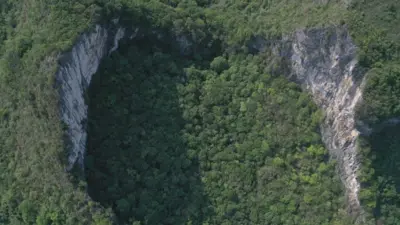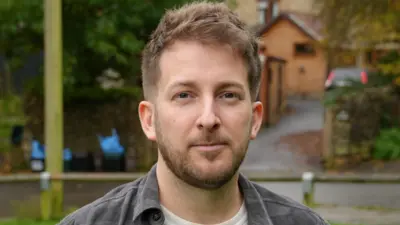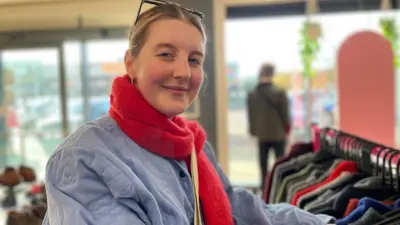We've updated our Privacy and Cookies Policy
We've made some important changes to our Privacy and Cookies Policy and we want you to know what this means for you and your data.
In pictures: Sophie Raworth and the 150-mile desert ultra-marathon
On Sunday, runners combated temperatures of 24.1C during the London marathon - the hottest on record. But for ґуПуґ«ГЅ News presenter Sophie Raworth, the unseasonable heat was nothing in comparison with the Marathon des Sables (MDS), a 150-mile ultra-marathon in the Sahara desert.
Image source, iancorless.com
It's known as the toughest foot race on earth. It's six marathons in five days, carrying everything you need to survive for the week. I signed up with some friends 18 months ago and trained hard for it.
It turned out to be the toughest - at times hellish - but most wonderful, rewarding experience I've ever had. Running down the dunes, wearing gaiters to stop the sand getting in my shoes, is something I will never forget.
Image source, iancorless.com
We arrived in camp after a six-hour coach journey deep into southern Morocco. I was with my great friend Susie Chan, an endurance runner, who had already run the MDS three times. Our backpacks had to be checked and weighed to ensure we had enough food for the week as well as the compulsory equipment: a sleeping bag, compass, venom pump and a whistle.
My pack weighed almost 9kg (20lb) without water. Thankfully it got lighter during the week as I ate my way through it.
Image source, iancorless.com
The start of the race is legendary. About 1,000 runners were there, but only 175 women had signed up. Helicopters hovered overhead as Patrick Bauer, the Frenchman who started the race 33 years ago, waved us all off to the sound of Highway to Hell blasting out over the desert.
Image source, iancorless.com
On the first day we ran 18 miles, most of it across sand dunes. Living in London, I've not had much experience of running on sand. It drained our legs. We took it very easy, knowing full well what was ahead that week. Some people went out far too hard in the heat and ended up on drips in the medical tent back at camp.
Image source, Marathon des Sables
The camp was vast and always on the move. Every morning, as we streamed to the start line, an army of Berbers moved in, took our tents down and then drove them 20 or 30 miles away to the next campsite.
Image source, iancorless.com
Camp life was almost as important as the running. You shared your open-sided home with seven other runners, sleeping side-by-side on the stony desert floor. After five or six hours of running, we returned every day to our tent and collapsed, too tired to move. Life became very simple. There was no phone signal. You lived in a bubble of sore feet, banter and a lot of laughter.
Image source, iancorless.com
Food was obviously all-important. The rules said you had to carry at least 2,000 calories a day. I had a tiny stove and a pot in which I could boil water for my freeze-dried breakfast and dinner. Lunch was eaten on the move and mainly snacks and powdered energy drinks. We burned off far more calories than we could carry. I came home almost a stone lighter.
Image source, iancorless.com
Out in the desert, you quickly learn to put your inhibitions behind you. These were the loos. You got two brown plastic bags as you crossed the finish line each day. Inside each cubicle is a plastic seat with a hole in the middle for the bag. I'll leave the rest to your imagination. There were no showers either. We stayed in the same clothes for nine days.
Image source, iancorless.com
I was amazed by the desert landscape. It was so vast and varied. We did a lot of climbing - at least 2,000ft (600m) a day - scaling jebels (mountains) and running along ridges. It was exhilarating.
Image source, iancorless.com
The most feared part of the MDS was day four - the long stage. It's 54 miles in one go and the organisers don't make it easy. We climbed 4,000ft that day and as night fell we found ourselves deep in the sand dunes. It was hell.
We were hungry, our feet hurt and we still had a long way to go. We didn't get back to camp until 01:45, after 17 hours on the go.
Image source, iancorless.com
We woke at dawn every morning, had breakfast, taped up our feet, then repacked our rucksacks before heading to the start line. I was lucky. I got only a few blisters. Some runners really suffered though. Our friend in the tent next door was in agony after the soles of his feet blistered. He still managed to finish the race.
Image source, @susie_chan_
On the final day we ran a full marathon - 26.2 miles. We set off in a sandstorm. But we had become quite used to them by then. Halfway through the week, a sandstorm tore through camp in the middle of the night. We laid in the remains of our tents for four hours as the storm blew through, filling our sleeping bags and mouths with sand.
Image source, Marathon des Sables
I crossed the finish line with my friends Susie, Shaun and Tim. Somehow we had managed to run every step of the 150 miles together. We all had tough moments during the week but managed to push and pull each other through it. I cried when I crossed the finish line. I couldn't believe I'd actually done it. But the Saharan sands have taught me that my body is so much stronger than my mind ever believed.
You can follow Sophie's running exploits on Twitter
Top Stories
More to explore
Most read
Content is not available








